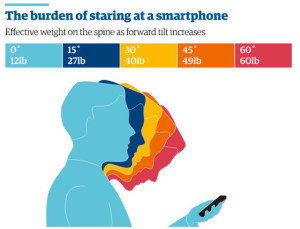iGadgets and Neck Pain
 Over the last 5 years, I have seen a surge in young adults visiting my office with neck pain. What’s interesting is that most of these patients have not been in serious car accidents or suffered any sort of whiplash injury, nor do they have arthritis. Rather, they have full neck mobility and are generally healthy people. However, they complain of neck pain, headaches, and sometimes numbness, tingling, or pain down an arm. Why the sudden increase in neck morbidity?
Over the last 5 years, I have seen a surge in young adults visiting my office with neck pain. What’s interesting is that most of these patients have not been in serious car accidents or suffered any sort of whiplash injury, nor do they have arthritis. Rather, they have full neck mobility and are generally healthy people. However, they complain of neck pain, headaches, and sometimes numbness, tingling, or pain down an arm. Why the sudden increase in neck morbidity?
The answer is the “head down posture” our necks assume when looking at an iGadget or laptop. The “head down posture” has not only increased the incidence of neck pain but caused earlier onset of neck pain as well.
How “head down posture” causes neck pain
When your neck is upright, the vertebrae in your neck support the bulk of the weight of your head. This is the most stable position for your neck. Once you look down to use your iGadget, your neck flexes forward and the vertebrae aren’t able to bear as much of your head weight. Instead, your neck’s muscles, tendons, ligaments, and intervertebral discs—the “soft tissue”— have to bear the brunt of the weight. Over time, the muscles in the front of your neck will tighten as a result of being overworked from having to hold the head in the “head down” position. Also, your spinal cord is pulled more taut, putting tension on the nerve roots which can create “pinched nerve” symptoms. The “head down posture” places abnormal mechanical stress on the joints resulting in more wear and tear and, ultimately, pain.
Patients often say that their neck feels “weak” and that it’s difficult to hold up their head. This leads them to slouch, which exacerbates the problem.
Treatment for neck pain caused by “head down posture”
Ergonomic education is an important part of my patients’ treatment plans. I instruct all patients in the following practices: to sleep with only one pillow under their necks; to hold their iGadgets at eye level when reading or texting; to drive with their heads against the headrest; to raise their monitor high enough so that the top of the monitor is level with the top of the heads; and, finally, to never ever use a laptop as their primary computer. If the laptop is the primary computer, it’s important for patients to raise it up high enough so that their necks will be upright in a neutral position and to add an external keyboard so that they can type with their shoulders relaxed. Also, always go for the biggest screen you can. I was deeply saddened to learn that Apple discontinued their 17-inch MacBook Pros. Yes, they were bulky. However, those extra 2 inches allowed the neck to be 10-15 degrees closer to neutral. In contrast, the 11-13 inch Macs are disastrous for neck structural stability especially when used for longer periods of time.
I also teach patients how to strengthen their deep cervical neck muscles; these are the muscles that run like a sleeve around your spine and are important stabilizers. There are many excellent YouTube videos that walk patients through such exercises. In-office tractions can also be utilized to correct structural problems that have resulted from chronic “head down posture.” At home, try lying flat on your back on your bed and then slowly let your head hang off the edge of the bed. This should feel good as it slightly decompresses your neck and stretches out the muscles in the front of your neck. If this is painful or challenging, your muscles have adaptively shortened to the point that they are restricting normal neck motion—correcting your posture should be top of mind.


